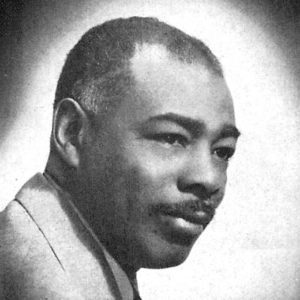calsfoundation@cals.org
Claude M. Lightfoot (1910–1991)
Claude Lightfoot was an Arkansas-born Communist who became involved in politics after moving to Chicago, Illinois. A frequent candidate for public office in Chicago from the 1930s to the 1950s, Lightfoot represents the impact of the Great Migration out of Arkansas and both the possibilities and limitations of black liberation in northern cities.
Claude M. Lightfoot was born on January 19, 1910, in Lake Village (Chicot County). His grandmother, who separated from her husband, acquired a farm of her own and raised her twelve children to adulthood. Shortly after Lightfoot’s birth, his parents moved to Little Rock (Pulaski County), where his father worked for a railroad company and his mother as a domestic worker, while young Claude stayed with his grandmother on the farm. He grew up hearing stories of slavery from his older family members. Lightfoot moved to Little Rock to live with his mother, Corrine, in 1916 and encountered class stratification in the black community. In 1918, near the beginning of the Great Migration, during which millions of African Americans left the rural South to find work in northern cities, Lightfoot’s family moved to Chicago.
Shortly after arriving, Lightfoot witnessed the 1919 Chicago race riots, which made a strong impression on him. As a teenager, he became particularly interested in the ideas of Marcus Garvey’s Pan-Africanism but soon decided they were unworkable and led to greater racial segregation. He briefly attended Virginia Union University but was expelled when the school discovered that he lacked a high school diploma. In his twenties, Lightfoot joined the Democratic Party and helped found the Young Men’s Black Democratic Club in 1930. Still influenced by Garvey, he believed in building black power through economic development. However, the Great Depression left him disillusioned with both the Democratic Party and capitalism. He ran for the state legislature on the Communist Party ticket in 1932, receiving 33,000 votes. He remained a Communist for the rest of his life.
In 1935, Lightfoot visited the Soviet Union as a delegate to the Seventh World Congress of the Communist International. Following the Communist Party line, he opposed U.S. intervention in World War II until the Nazis declared war on the Soviets in 1941; he then became an ardent believer in the war. He joined the U.S. Army, but the military reinforced his belief in what he saw as the corrupt nature of American institutions, and he experienced much racism. He returned to Chicago after the war, even more determined to fight for the Communist cause. He ran again for the Illinois legislature in 1946, this time against the wishes of party officials.
Lightfoot’s Communism put him in the crosshairs of anti-Communist forces as the Cold War deepened. Apparently in response to his running for elected office as a Communist and serving as the executive secretary of the Communist Party of Illinois, Lightfoot was arrested in 1954 for being in violation of the Smith Act of 1940, which made advocating the overthrow of the U.S. government illegal. In fact, he was the first person prosecuted under the clause reading “to teach and advocate the overthrow of the government of the United States by force and violence as speedily as circumstances would permit.” He was convicted, and a long legal process began. He appealed his conviction to the U.S. Supreme Court, and the conviction was overturned in 1964.
He had married Geraldyne Gray, a native of Mississippi whose family had also moved north in the Great Migration, in 1938. She was also a CPUSA organizer, although, as a woman, she had fewer organizing opportunities than her husband. They adopted a disabled son in 1955. She died of cancer in 1962. Lightfoot remarried twice, at least once to another Communist organizer, although there is little in the public record about his later life.
In 1973, he received an honorary doctorate from Universität Rostock in East Germany after writing Racism and Human Survival: Lessons of Nazi Germany for Today’s World. He also received awards and honors from both the Bulgarian and Soviet Communist parties. In 1986, he published his autobiography, Chicago Slums to World Politics: Autobiography of Claude M. Lightfoot.
Lightfoot moved to Gary, Indiana, in 1973, and lived there for the rest of his life. He died on July 17, 1991, and is buried in Forest Home Cemetery in Forest Park, Illinois.
For additional information:
Claude M. Lightfoot Papers. Chicago History Museum Research Center, Chicago, Illinois.
Lightfoot, Claude. Chicago Slums to World Politics: Autobiography of Claude M. Lightfoot. New York: New Outlook Publishers, 1980.
Erik Loomis
University of Rhode Island
 Civil Rights and Social Change
Civil Rights and Social Change Early Twentieth Century, 1901 through 1940
Early Twentieth Century, 1901 through 1940 Politics and Government
Politics and Government Claude Lightfoot
Claude Lightfoot 




Comments
No comments on this entry yet.